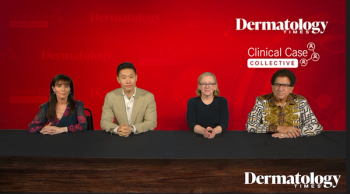Articles by James Song, MD, FAAD

Panelists discuss how evolving concerns about long-term topical corticosteroid use are prompting a shift toward safer, nonsteroidal alternatives such as roflumilast, emphasizing structured treatment plans, early patient education, and improved office workflows to support individualized, steroid-sparing psoriasis care that enhances both outcomes and trust.

Panelists discuss how the availability of both roflumilast foam and cream allows for personalized, preference-driven treatment plans that enhance adherence while streamlined access strategies and improved topical efficacy are reshaping the role of nonsteroidal agents in psoriasis care, extending their use beyond mild disease to special sites and even as systemic-sparing options.

James Song, MD, FAAD, reveals insights on abrocitinib's safety in atopic dermatitis, highlighting lower conjunctivitis rates compared to dupilumab at DERM 2025.

Panelists discuss how roflumilast foam, though newly approved for scalp psoriasis, is already showing promise off-label for conditions such as seborrheic dermatitis and nail psoriasis, thanks to its well-tolerated, alcohol- and propylene glycol–free vehicle that improves patient comfort, adherence, and expands topical options for difficult-to-treat areas—potentially reducing reliance on systemic therapies.

Panelists discuss how the recent FDA approval of roflumilast foam for scalp psoriasis represents a significant advancement, combining strong efficacy with a gentle, moisturizing vehicle that enhances tolerability and adherence across diverse hair types and skin tones while offering a steroid-sparing option free from common adverse effects such as hypopigmentation.

Panelists discuss how safety and tolerability are key advantages of newer topical psoriasis treatments such as tapinarof and roflumilast, which avoid many steroid-related risks such as hypothalamic-pituitary-adrenal (HPA) axis suppression and skin thinning, cause minimal irritation, and have favorable real-world profiles that support their use as effective, long-term, steroid-sparing therapies.

Panelists discuss how recent innovations like topical tapinarof and roflumilast are transforming plaque psoriasis treatment by offering nonsteroidal, effective, and well-tolerated options that modulate immune pathways for long-term management while noting the ongoing need for scalp-friendly formulations to improve usability and adherence in patients with scalp involvement.

Psoriasis in high impact areas responded well to icotrokinra, presenting a potential exciting option for patients.

Panelists discuss how an ideal topical for widespread psoriasis—including scalp and sensitive areas—would be a single, nonsteroidal, well-tolerated agent with steroidlike efficacy, capable of supporting both proactive flare prevention and rapid itch relief while improving adherence, quality of life, and long-term disease control.

James Song, MD, discussed his UnlIMMited DERM 2025 poster detailing risankizumab's efficacy for genital and scalp psoriasis.

Panelists discuss how diagnosing and treating psoriasis in patients with skin of color requires awareness of atypical presentations, hair and cultural considerations, and systemic treatment disparities, highlighting the value of safe, broadly effective, and cosmetically acceptable topicals to support earlier and more equitable care.

Panelists discuss how treating scalp psoriasis remains challenging due to poor compatibility of traditional topicals with hair and scalp characteristics, emphasizing the need for cosmetically acceptable, well-tolerated formulations that improve adherence and reduce premature escalation to systemic therapy.

Panelists discuss how topical therapies remain essential in psoriasis management across all severities, highlighting the need for simplified, steroid-sparing treatment options that are safe, effective, and easy to use—especially to improve adherence and address patient concerns about adverse effects and complexity.

Panelists discuss how medical professionals anticipate new IL-17 inhibitor data, particularly from head-to-head trials like BE BOLD. Interest is growing in sonelokimab, an IL-17A/F nanobody (Papp, 2021). Further research is needed on long-term efficacy, safety, and optimal patient selection.

James Song, MD, FAAD, discusses how emerging topical JAK inhibitors like ruxolitinib cream may reduce the necessity for systemic therapies in select pediatric atopic dermatitis patients by effectively controlling moderate disease and potentially serving as long-term maintenance therapy with a favorable safety profile.

James Song, MD, FAAD, discusses how clinicians should evaluate treatment response based on objective measures including BSA involvement, EASI scores, and pruritus ratings when determining whether to escalate from topical ruxolitinib to systemic therapy or de-escalate to maintenance treatment in pediatric atopic dermatitis patients.

James Song, MD, FAAD, discusses how topical Janus kinase inhibitors offer distinct advantages for children with moderate atopic dermatitis by providing effective inflammation control without the adverse effects of topical corticosteroids, particularly in sensitive areas like the face and intertriginous regions.

James Song, MD, FAAD, discusses how ruxolitinib cream addresses a significant treatment gap in pediatric atopic dermatitis by providing a non-steroidal topical option with efficacy comparable to medium-potency corticosteroids but without the associated safety concerns.

Panelists discuss how data from head-to-head clinical trials comparing different therapeutic options in atopic dermatitis inform treatment decisions while exploring critical gaps in research that future studies need to address.

Panelists discuss how head-to-head trials in psoriasis provide direct efficacy and safety comparisons between IL-17 inhibitors and other drug classes. Studies like BE RADIANT, BE VIVID, and IXORA-R highlight bimekizumab’s and ixekizumab’s superiority over secukinumab and ustekinumab. CLARITY and COBRA compare IL-17 to IL-23 inhibitors, while IMMerge and BE BOLD explore risankizumab’s role. These trials inform treatment decisions by guiding biologic selection based on efficacy, durability, and safety.

James Song, MD, FAAD, discusses how the treatment of pediatric atopic dermatitis (AD) demands personalized consideration of disease severity, patient age, affected areas, and treatment history. Ruxolitinib cream may address gaps by providing a nonsteroidal alternative with fewer adverse effects, potentially delaying or reducing systemic therapy needs.

Panelists discuss how long-term data confirm the sustained efficacy and safety of IL-17 inhibitors in psoriasis. Secukinumab (Bissonnette, 2018; Langley, 2022) and ixekizumab (Blauvelt, 2021) show durable PASI responses over 5 years. Brodalumab’s 5-year pharmacovigilance (Lebwohl, 2024) and 120-week data (Puig, 2020) support its long-term use. Bimekizumab’s 4-year data (Blauvelt, 2024; Gordon, 2024) demonstrate continued efficacy, with 5-year results anticipated at AAD 2025.

Panelists discuss how to identify suitable patients for JAK inhibitor therapy by evaluating disease severity, medical history, risk factors, and individual treatment goals while considering contraindications and safety considerations.

Panelists discuss how individual patient characteristics, including comorbidities, treatment history, and personal preferences, guide therapeutic decision-making for a 38-year-old woman with severe atopic dermatitis.

Panelists discuss how when prescribing an IL-17 inhibitor, key safety considerations include infection risk (particularly tuberculosis and fungal infections), inflammatory bowel disease exacerbation, allergic reactions, neutropenia, immunogenicity, vaccination timing, pregnancy/breastfeeding status, malignancy history, and monitoring requirements for adverse events.

Panelists discuss how IL-17 inhibitors are generally well-tolerated, but common adverse effects include infections, particularly candidiasis, and potential increased suicidal ideation risk. Patients should be informed of candidiasis risk, especially with bimekizumab (Gordon, 2022), and monitored for mood changes, as IL-17s and IL-23s may impact mental health (Blauvelt, 2023). Open discussions help assess risks while ensuring treatment benefits.

Panelists discuss how IL-17 inhibitors are considered for plaque psoriasis based on disease severity, comorbidities, and patient preference. Selection factors include efficacy, safety, access, and cost. Clinical trial data guide choices, but real-world factors impact use. Dosing varies: secukinumab (300 mg weekly for 5 weeks, then monthly), ixekizumab (160 mg at week 0, then 80 mg biweekly for 12 weeks, then monthly), brodalumab (210 mg weekly for 3 weeks, then biweekly), and bimekizumab (320 mg every 4 weeks for 16 weeks, then every 8 weeks). Dosing and device options influence prescribing decisions.

Panelists discuss how to optimize treatment outcomes by managing the transition from biologics to JAK inhibitors and considering dose adjustment strategies when patients show inadequate response to initial therapy.

Panelists discuss how clinicians can recognize and address barriers to treatment advancement in a young adult with persistent moderate to severe atopic dermatitis by evaluating disease impact, patient concerns, and appropriate therapeutic options.

Panelists discuss how unique characteristics of different JAK inhibitors, including selectivity profiles, administration routes, and clinical efficacy data, inform treatment selection in real-world practice.










